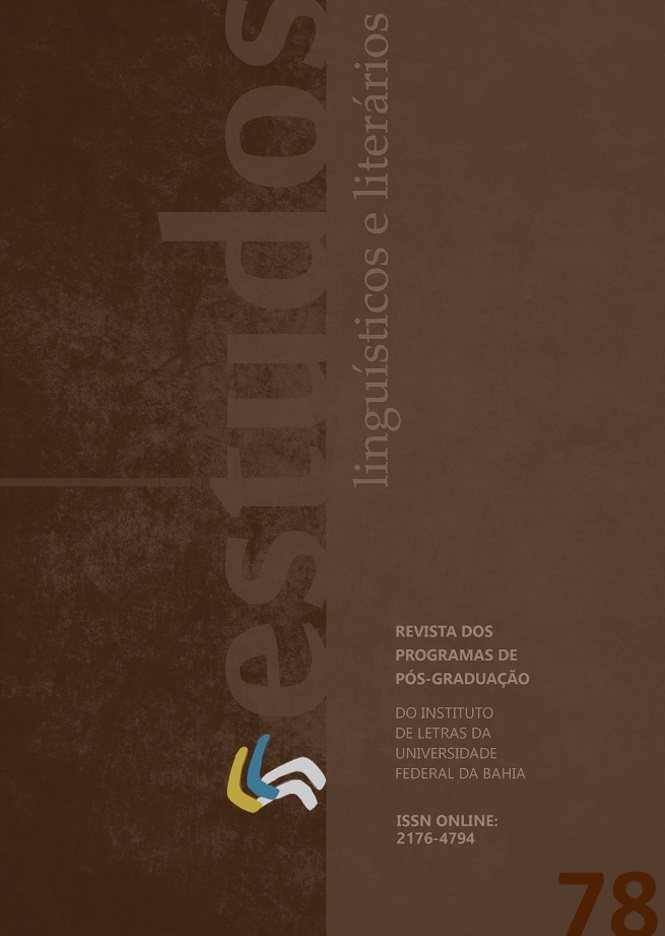THE INTERFACES BETWEEN LANGUAGE AND EMOTION:
THE CASE OF MIXED EMOTIONS
DOI:
https://doi.org/10.9771/ell.v0i78.55523Keywords:
Language; Mixed Emotions; Social CognitionAbstract
This paper addresses the issue of mixed emotions and their relation with language. The main goal is to analyze the characteristics of works carried out on the phenomenon and the linguistic issues related to it. A mixed emotion is an emotional state that comprises two different emotions, such as feeling happy and sad at the same time. The theoretical perspective adopted is based on Damásio (2018), de Waal (2021), Foolen (2016), Larsen et al. (2001) and Vaccaro et al. (2020). Methodologically, we carried out a bibliographic survey on research on mixed emotions in the last 30 years. Findings indicate that: there are different stimuli and tasks used in the field; the most researched age range is between 4 and 11 years old; the most investigated emotional blend is “happy and sad”; the words “happy” and “sad” are more frequent than linguistic blends.
Downloads
References
BERNARDINO, Leonardo G.; FIGUEIREDO, Thuany T. Percepção subjetiva de tempo de palavras com conteúdo emocional. Letrônica, 16, n. 1, p. e44333-e44333, 2023.
BROOKS, Jeffrey A.; SHABLACK, Holly; GENDRON, Maria; SAPTUTE, Ajay B.; PARRISH, Michael H.; LINDQUIST, Kristen A. The role of language in the experience and perception of emotion: a neuroimaging meta-analysis. Social Cognitive and Affective Neuroscience, 12, n. 2, p. 169-183, 2017.
CHOE, Katherine S.; KEIL, Frank C.; BLOOM, Paul. Children's understanding of the Ulysses conflict. Developmental Science, 8, n. 5, p. 387-392, 2005.
DAMÁSIO, António. A estranha ordem das coisas: as origens biológicas dos sentimentos e da cultura. São Paulo: Editora Companhia das Letras, 2018.
DE WAAL, Frans. O último abraço da matriarca: As emoções dos animais e o que elas revelam sobre nós. São Paulo: Editora Schwarcz-Companhia das Letras, 2021.
DONALDSON, Sally K.; WESTERMAN, Michael A. Development of children's understanding of ambivalence and causal theories of emotions. Developmental psychology, 22, n. 5, p. 655, 1986.
FIGUEIREDO, Thuany Teixeira de. Linguagem e Teoria da Mente de segunda ordem: investigando os estados mentais de ignorância e crença falsa. 2018. 184f. Dissertação (Mestrado em Linguística). Instituto de Estudos da Linguagem, Universidade Estadual de Campinas, Campinas, 2018.
FOOLEN, Ad. A relevância da emoção para a linguagem e para a Linguística. In: CAVALCANTE, S. M. S.; MILITÃO, J. A. (orgs.). Emoções: desafios para estudos da linguagem e cognição. Belo Horizonte: PUC Minas, 2016. p. 13-39.
FRANCO, Maria da Glória S. D. E. C; SANTOS, Natalie N. Desenvolvimento da compreensão emocional. Psicologia: Teoria e pesquisa, 31, p. 339-348, 2015.
HARTER, Susan; BUDDIN, Bonnie J. Children's understanding of the simultaneity of two emotions: A five-stage developmental acquisition sequence. Developmental psychology, 23, n. 3, p. 388, 1987.
KAGAN, Jerome. What is emotion?: History, measures, and meanings. Yale: Yale University Press, 2007.
KESTENBAUM, Roberta; GELMAN, Susan A. Preschool children's identification and understanding of mixed emotions. Cognitive Development, 10, n. 3, p. 443-458, 1995.
LARSEN, Jeff T.; MCGRAW, A. Peter; CACIOPPO, John T. Can people feel happy and sad at the same time?. Journal of personality and social psychology, 81, n. 4, p. 684-696, 2001.
LARSEN, Jeff T.; TO, Yen M.; FIREMAN, Gary. Children's understanding and experience of mixed emotions. Psychological Science, 18, n. 2, p. 186-191, 2007.
NÓBREGA, Vitor Augusto; MINUSSI, Rafael Dias. O tratamento da morfologia não-concatenativa pela morfologia distribuída: o caso dos blends fonológicos. Revista Letras, n. 91, p. 158-177, 2015.
ROAZZI, Antonio; DIAS, Maria da Graça B. B.; SILVA, Janaína O. D.; SANTOS, Luciana B. D.; ROAZZI, Maíra M. O que é emoção? Em busca da organização estrutural do conceito de emoção em crianças. Psicologia: Reflexão e Crítica, 24, p. 51-61, 2011.
SMITH, Joshua P.; GLASS, Daniel J.; FIREMAN, Gary. The understanding and experience of mixed emotions in 3–5-year-old children. The Journal of genetic psychology, 176, n. 2, p. 65-81, 2015.
VACCARO, Anthony. G.; KAPLAN, Jonas T.; DAMASIO, António. Bittersweet: the neuroscience of ambivalent affect. Perspectives on Psychological Science, 15, n. 5, p. 1.187-1.199, 2020.
WINTRE, Maxine Gallander; VALLANCE, Denise D. A developmental sequence in the comprehension of emotions: Intensity, multiple emotions, and valence. Developmental psychology, 30, n. 4, p. 509, 1994.
ZAJDEL, Ruth T.; BLOOM, Jill Myerow; FIREMAN, Gary; LARSEN, Jeff T. Children's understanding and experience of mixed emotions: The roles of age, gender, and empathy. The Journal of genetic psychology, 174, n. 5, p. 582-603, 2013.


